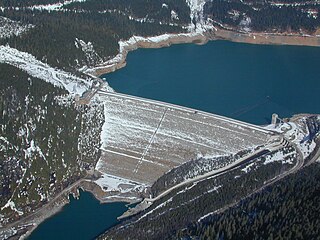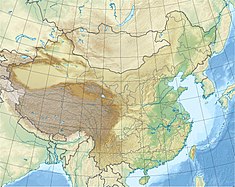
The Qing River is a right (southern) tributary of the Yangtze River in Hubei province of south-central China.

Falcon Dam is an earthen embankment dam on the Rio Grande between Starr County in the U.S. state of Texas and the city of Nueva Ciudad Guerrero in the Mexican state of Tamaulipas. The dam was built for water conservation, irrigation, hydroelectric power generation, flood control, and recreational purposes and as an international border crossing between Zapata and Starr Counties and Tamaulipas. Construction on the dam began in December 1950 and ended in April 1954 but it was dedicated by presidents Adolfo Ruiz Cortines and Dwight D. Eisenhower in October 1953.

Nuozhadu Dam is an embankment dam on the Lancang (Mekong) River in Yunnan Province, southwest China. The dam is 261.5 m (858 ft) tall, and creates a reservoir with a normal capacity of 21,749,000,000 m3 (17,632,000 acre⋅ft) at a level of 812 m (2,664 ft) asl. The purpose of the dam is hydroelectric power production along with flood control and navigation. The dam supports a power station with nine generators, each with generating capacity of 650 MW. The total generating capacity of the power station is 5,850 MW. Construction on the project began in 2004; the dam's first generator went online 6 September 2012 and the last generator was commissioned in June 2014. The construction and management of the project was implemented by Huaneng Power International Ltd., which has a concession to build, own and operate hydroelectric dams on China's stretch of the Mekong River.

The Ertan Dam is an arch dam on the Yalong River, a tributary of the Yangtze River in Sichuan Province, southwest China.

The Kannagawa Hydropower Plant (神流川発電所) is an under construction pumped-storage hydroelectric power plant near Minamiaiki in Nagano Prefecture and Ueno in Gunma Prefecture, Japan. The power plant utilizes the Minamiaiki River along with an upper and lower reservoir created by two dams, the upper Minamiaiki Dam and the lower Ueno Dam. The power station in between the two dams will contain six 470 megawatts (630,000 hp) pump-generators for a total installed capacity of 2,820 megawatts (3,780,000 hp). Unit 1 commenced commercial operation in 2005 and Unit 2 in 2012. When completed, the plant will have the second-largest pumped-storage power capacity in the world.

The Itá Hydroelectric Power Plant is a dam and hydroelectric power plant on the Uruguay River near Itá on the border of Santa Catarina and Rio Grande do Sul, Brazil. The power station has a 1,450 megawatts (1,940,000 hp) capacity and is supplied with water by a concrete face rock-fill embankment dam. It is owned and operated by Tractebel Energia and produces the equivalent of 60% of the energy consumed in Santa Catarina.

The Shuangjiangkou Dam(Chinese: 双江口大坝/双江口水电站), also referred to as Shuang Jiang Kou(Chinese: 双江口), is an embankment dam currently being constructed on the Dadu River in Sichuan Province, China. When completed, the 312 metres (1,024 ft) tall dam will be the tallest dam in the world. Preliminary construction began in 2008 and the entire project is expected to be complete in 2018. By April 2011, over 200,000,000 m3 (261,590,124 cu yd) of material had been excavated from the construction site. In March 2013 the China's Ministry of Environmental Protection approved construction on the dam's superstructure and associated facilities. The government acknowledged that the dam would have negative impacts on the environment but that developers were working to mitigate them. The dam is being built by the Guodian Group at a cost of US$4.02 billion. The entire construction period is expected to last 10 years.

The Dachaoshan Dam is a gravity dam on the Lancang (Mekong) River in Yunnan Province, China. The sole purpose of the dam is hydroelectric power production as it supplies water to a power station containing six 225 MW generators for a total installed capacity of 1,350 MW.

The Jiangpinghe Dam is a concrete face rock-fill embankment dam on the Loushui River near Jiangpinghe village, Zouma Town, in Hefeng County in Hubei Province, China. The purpose of the dam is hydroelectric power generation, flood control and irrigation. The dam houses a hydroelectric power station with 2 x 250 MW generators for a total installed capacity of 500 MW. Its expected generation of 1005 GWh will be transferred to the Central China Power Grid. Construction on the dam began in 2005 and the first generator went online in July 2012. The dam is 221 metres (725 ft) tall, withholding a 1,366,000,000 cubic metres (1,107,434 acre⋅ft) reservoir of which 787,000,000 cubic metres (638,031 acre⋅ft) is active or "useful" storage.

The Fengman Dam is a concrete gravity dam 20 km (12 mi) from Jilin City on the Second Songhua River in Jilin Province, China. The main purposes of the dam are hydroelectric power generation and flood control. Construction of the dam began in 1937 and was complete in 1953. Northeast China Grid Company Limited, the dam's owner, plans on rebuilding it in the future.

The Guanyinyan Dam is a gravity dam on the Jinsha River 30 km (19 mi) southwest of Panzhihua on the border of Yunnan and Sichuan Provinces in China. The purpose of the dam is hydroelectric power generation and flood control. Construction on the dam started in 2008 and the river was diverted by 2010. The first generator was operational on 20 December 2014 and the fourth on 14 December 2015. The entire power station should be operational by 2016. When complete, the dam will support a 3,000 MW power station consisting of five 600 MW Francis turbine generators.

The Jishixia Dam is a concrete face rock-fill embankment dam on the Yellow River in Qinghai Province, China. It is 101 m (331 ft) tall and downstream from the Gongboxia Dam. The purpose of the dam is hydroelectric power generation and flood control. The dam supports a power station with 3 x 340 MW Francis turbines for a total installed capacity of 1,020 MW. Construction on the dam began in 2005 and the river was diverted in March 2007. The first generator was operational in mid-2010 and the rest by the end of the year.

The Votkinsk Hydroelectric Station is a dam and hydroelectric power station on the Kama River along the border of Perm Krai and Udmurtia, Russia. It is 30 km (19 mi) south of Votkinsk and its main purpose is power generation and navigation. The power station has a 1,020 MW installed capacity and the dam also supports a ship lift. Construction on the dam began in 1955, the first generator was operational in 1961 and the last in 1963. The entire project was complete in 1965.

The Lianghekou Dam is a concrete-face rock-fill dam currently under construction on the Yalong River in Yajiang County, Sichuan Province, China. The dam is located at the confluence of the Yalong, Xianshui and Qingda Rivers. The 295 m (968 ft) tall dam will be the highest embankment dam in the country and support a 3,000 MW power station. Studies for the dam were completed between 2005 and 2009 with preliminary construction beginning that year. Major works on the dam officially began in October 2014. The first generator is expected to be commissioned in 2021 and the project complete in 2023.

La Yesca Dam is an embankment dam on the Santiago River 90 km (56 mi) northwest of Guadalajara on the border of Mexico's Nayarit and Jalisco states. Construction on the dam began in 2007 after Empresas ICA was awarded the main construction contract. The dam was inaugurated by President Felipe Calderón on 6 November 2012. The dam supports a 750 MW hydroelectric power station and is part of the Hydroelectric System Santiago. Its construction will improve the regulation of water flow and subsequently power generation downstream at the El Cajón and Aguamilpa Dams.

The Bashan Dam is an embankment dam on the Renhe River located 15 km (9 mi) northwest of Chengkou County's seat in Chongqing, China. The primary purpose of the dam is hydroelectric power generation and it supports a 140 MW power station containing two 70 MW Pelton turbine-generators. It is a concrete-face rock-fill type with a height of 155 m (509 ft); creating a reservoir with a capacity of 315,000,000 m3 (412,004,445 cu yd). The dam is located before a bend in the river and diverts water through a 2,181 m (7,156 ft) long headrace tunnel that leads to the power station. Construction on the project began in 2005, the river was diverted by 2006 and the generators operational in 2009.

The Huanglongtan Dam is a concrete gravity dam located on the Du River, a tributary of the Han River. It is located 25 km (16 mi) west of Shiyan in Hubei Province, China. The main purpose of the dam is hydroelectric power generation but it also provides for flood control. It was constructed between 1969 and 1976 and support a 510 MW power station.

The Daguangba Dam is a multi-purpose dam on the Changhua River in Hainan Province, China. It is located 35 km (22 mi) east of Dongfang. As the primary component of the Daguangba Multipurpose Project, the dam was constructed between 1990 and 1995. It serves to provide water for both hydroelectric power generation and agriculture. It supports a 240 MW power station and supplies water for the irrigation of 12,700 ha. It is also the largest dam and hydroelectric power station in Hainan.

The Pankou Dam is a concrete-face rock-fill dam on the Du River about 74 km (46 mi) southwest of Shiyan in Zhushan County of Hubei Province, China. The purpose of the dam is hydroelectric power production and flood control. It supports a 513 MW power station located at its base. At a normal reservoir elevation of 355 m (1,165 ft), the reservoir withholds 1,970,000,000 m3 (1,597,105 acre⋅ft) of water. However, it can hold up to 2,338,000,000 m3 (1,895,447 acre⋅ft) in the event of a flood. Construction on the dam began in May 2008 and its generators were commissioned in 2012.

The Reventazón Dam is a concrete-face rock-fill dam on the Reventazón River about 8 km (5.0 mi) southwest of Siquirres in Limón Province, Costa Rica. It was inaugurated on 16 September 2016, and its primary purpose is the production of hydroelectric power. The 1.4 billion USD project and largest power station in the country has an installed capacity of 305.5 MW and is expected to provide power for 525,000 homes. Construction on the dam began in 2009. At a height of 130 metres (430 ft) and with a structural volume of 9,000,000 m3 (12,000,000 cu yd), it is the largest dam in Central America. To produce electricity, water from the reservoir is diverted about 3 km (1.9 mi) to the northeast where it reaches the power station along the Reventazón River. Due to its environmental features, like offset habitats and migration corridors for jaguars and many other species, the project could be a model for other future hydroelectric power plants.




















